

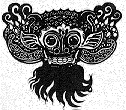
or, "NO, I don't want a #@%%*$# Bemo, massage, post card, plait your hair, bracelet, watches, money belt, necklace, magic mushroom or jiggy jig!"
On the Road to Ubud
The following day was our last day in Legian. We spend a lazy morning going down the beach to Kuta (OK, it was kind of a bribe to get Kathryn going shopping again - we didn't tell her there were shops at Kuta!). The other reason for going by the beach rather than down Jalan Legian ("Jalan" means street or road), was that the narrow strip of sand between the waters edge and the dry sand is a "no go" area for the hawkers. You can walk safely without being bothered.It was an interesting walk anyway. we picked up small pieces of coral washed in from the reefs, and watched as the small burrowing sand crabs scurried across the sand and dug down.
We spent the late morning and afternoon at Kuta in the Matahari and other small craft shops, buying up cloths (the childrens cloths were particularly well priced), books, and other small items. At this point we began to notice that some of the shops were starting to be stripped of goods (and not just by us!) because of the falling exchange rates. When they were replenished it would be at higher prices as inflation becomes a problem).
The walk back up Jalan Legian was uneventful, a few last minute items including a great tee-shirt bearing the subtitle of this story (see above) emblazoned in large black letters. We thought, how very Bali!
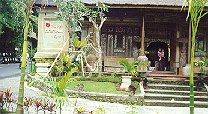 The next morning was time to pack all our things up again as we left our hotel in Legian and were transported to Ubud. Ubud is the traditional center for arts and crafts in Bali, having been chosen in the past by European artist such as Walter Spies, Willem Hofker, Arie Smit and others. The artists encouraged the local Balinese in their arts, giving paints to the village children, who eventually developed their own style known as The Young Artists, along side the more traditional Balinese art.
The next morning was time to pack all our things up again as we left our hotel in Legian and were transported to Ubud. Ubud is the traditional center for arts and crafts in Bali, having been chosen in the past by European artist such as Walter Spies, Willem Hofker, Arie Smit and others. The artists encouraged the local Balinese in their arts, giving paints to the village children, who eventually developed their own style known as The Young Artists, along side the more traditional Balinese art.
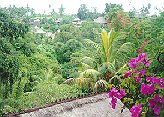 Our hotel, the Hotel Tjampuhan (above), was built around the cottage that Walter Spies had lived in, a short distance from the town of Ubud, by the junction of two rivers. Such a place is auspicious for the Balinese, and there is of course a temple deep in the tropically vegetated ravine where the rivers meet. The hotel itself is practically all open air. The picture to the right is the view from the reception area looking back towards Ubud and over the ravine.
Our hotel, the Hotel Tjampuhan (above), was built around the cottage that Walter Spies had lived in, a short distance from the town of Ubud, by the junction of two rivers. Such a place is auspicious for the Balinese, and there is of course a temple deep in the tropically vegetated ravine where the rivers meet. The hotel itself is practically all open air. The picture to the right is the view from the reception area looking back towards Ubud and over the ravine.
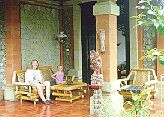 The rooms at the hotel (left) are grouped into separate bungalows of three or four rooms spaced along the sides of the steep ravine. All around in lush tropical vegetation. There are no glass windows on the rooms, only fly-wire screens, and no air conditioning. It makes for a rather more tropical feel to the place, and we could imaging what it must have been like for the early European travellers through here. The other interesting feature of the rooms is the padlocks used to lock the rooms - they simply hook through two large rings, one on each door.
The rooms at the hotel (left) are grouped into separate bungalows of three or four rooms spaced along the sides of the steep ravine. All around in lush tropical vegetation. There are no glass windows on the rooms, only fly-wire screens, and no air conditioning. It makes for a rather more tropical feel to the place, and we could imaging what it must have been like for the early European travellers through here. The other interesting feature of the rooms is the padlocks used to lock the rooms - they simply hook through two large rings, one on each door.
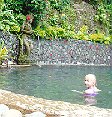 Ubud is in the hills halfway between the coast and Mount Batur, where we had been a few days previously). It is slightly(!) cooler than the coast, being at a slightly higher altitude. However, it is still humid and sticky and Kathryn wasted no time in finding one of the two pools at the hotel - a natural spring. In true Balinese style, there is a statue of a goddess out which the cool water flows. We also noticed the many hibiscus flows carefully placed around the many winding paths between the hotal bungalows, and on many of the statues and ornaments at the hotel. We were later to observe these being replaced daily by one of the hotel staff. Its strange, but such adornments really help heighten the tropical feel.
Ubud is in the hills halfway between the coast and Mount Batur, where we had been a few days previously). It is slightly(!) cooler than the coast, being at a slightly higher altitude. However, it is still humid and sticky and Kathryn wasted no time in finding one of the two pools at the hotel - a natural spring. In true Balinese style, there is a statue of a goddess out which the cool water flows. We also noticed the many hibiscus flows carefully placed around the many winding paths between the hotal bungalows, and on many of the statues and ornaments at the hotel. We were later to observe these being replaced daily by one of the hotel staff. Its strange, but such adornments really help heighten the tropical feel.
On exploring the hotel further, we found the other pool down the side of the ravine further. There some workes were busy building a new spa pool room. We watch in awe as the workers went about their business, carting all the cement powder, bricks and bucket loads of soil and sand on their heads down the slope from the road. All the concrete was mixed by hand (it would have been near impossible to get machinery down there). The impression was of humanity working like ants. The workers were very friendly, and we would often smile and say hello as we passed them on the narrow winding paths.
After settling into the hotel, we venture out to explore Ubud. The hotel is over on the western side of the Wos River, not far from the main road bridge over the deep ravine. There is an old suspension bridge, built in the old Dutch colonial days. It has been replaced by a larger structure in recent years. Walking up the winding road on the other bank, we pass many cratf shops where local artisans work and sell their wares. The road passes through a large cutting in the hill, and we enter the main street of Ubud itself.
 There are many resteraunts and cafes in Ubud. We stop for a late lunch at one called Ary's Cafe. There are conventional style tables as well as eastern style low tables with cushions. Kathryn is keen to try these. After a drink, of course, she wants to use the toilet. Thats when we find the "open air" concept has been taken to extremes. These have been constructed with a stone wall surrounding an open air garden, right next to the toilet seat! You've heard of "alfresco dinning", well, how about "alfresco toilets"? I couldn't resist taking a picture, and judging by the reaction of other tourists, I wasn't the only one!
There are many resteraunts and cafes in Ubud. We stop for a late lunch at one called Ary's Cafe. There are conventional style tables as well as eastern style low tables with cushions. Kathryn is keen to try these. After a drink, of course, she wants to use the toilet. Thats when we find the "open air" concept has been taken to extremes. These have been constructed with a stone wall surrounding an open air garden, right next to the toilet seat! You've heard of "alfresco dinning", well, how about "alfresco toilets"? I couldn't resist taking a picture, and judging by the reaction of other tourists, I wasn't the only one!
There are very few hawkers in Ubud, not because there are no tourists. On the contrary, there are many tourists in this famous town. It's just that the local prince has band them, except around the market at the main cross roads. There are still the transport touts, and the occasional seller of tickets to the daily cultural performances, but not the constant pressure to buy things you don't really want.
 Walking on further we pass a small shop selling music and an assortment of icecreams and general groceries, there is an alluring sound of exotic Indonesian music drifting out. We sit and enjoy an icecream and the relaxing music.
Walking on further we pass a small shop selling music and an assortment of icecreams and general groceries, there is an alluring sound of exotic Indonesian music drifting out. We sit and enjoy an icecream and the relaxing music.
After much walking we rest at another cafe called the Lotus Cafe. It is built next to a temple across a large pond filled with lotus flowers. There is repair work underway on the temple gate (hence the orange tapaulin in the picture at the left). It was a very relaxing afternoon as we sat there - the first such rest in a while. We spent the early evening here having dinner, and then walked back to the hotel.
Click on the bemo for the last day in Bali.
[Go back to main page] |
[Go to previous page]
[Read back issues of The Tazy Tattler] |
[Send an E-mail to Andrew]
© Copyright AAW 1998
This page hosted by Geocities
